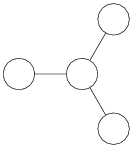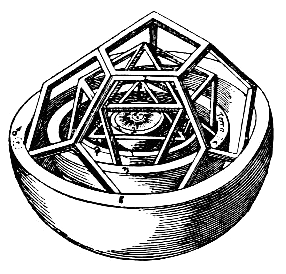In mathematics, a Clifford algebra is an algebra generated by a vector space with a quadratic form, and is a unital associative algebra with the additional structure of a distinguished subspace. As K-algebras, they generalize the real numbers, complex numbers, quaternions and several other hypercomplex number systems. The theory of Clifford algebras is intimately connected with the theory of quadratic forms and orthogonal transformations. Clifford algebras have important applications in a variety of fields including geometry, theoretical physics and digital image processing. They are named after the English mathematician William Kingdon Clifford (1845–1879).

In mathematics, the general linear group of degree n is the set of n×n invertible matrices, together with the operation of ordinary matrix multiplication. This forms a group, because the product of two invertible matrices is again invertible, and the inverse of an invertible matrix is invertible, with the identity matrix as the identity element of the group. The group is so named because the columns of an invertible matrix are linearly independent, hence the vectors/points they define are in general linear position, and matrices in the general linear group take points in general linear position to points in general linear position.

In mathematics, a root system is a configuration of vectors in a Euclidean space satisfying certain geometrical properties. The concept is fundamental in the theory of Lie groups and Lie algebras, especially the classification and representation theory of semisimple Lie algebras. Since Lie groups and Lie algebras have become important in many parts of mathematics during the twentieth century, the apparently special nature of root systems belies the number of areas in which they are applied. Further, the classification scheme for root systems, by Dynkin diagrams, occurs in parts of mathematics with no overt connection to Lie theory. Finally, root systems are important for their own sake, as in spectral graph theory.

In the mathematical field of Lie theory, a Dynkin diagram, named for Eugene Dynkin, is a type of graph with some edges doubled or tripled. Dynkin diagrams arise in the classification of semisimple Lie algebras over algebraically closed fields, in the classification of Weyl groups and other finite reflection groups, and in other contexts. Various properties of the Dynkin diagram correspond to important features of the associated Lie algebra.

In mathematics, a simple Lie group is a connected non-abelian Lie group G which does not have nontrivial connected normal subgroups. The list of simple Lie groups can be used to read off the list of simple Lie algebras and Riemannian symmetric spaces.

In mathematics, G2 is three simple Lie groups (a complex form, a compact real form and a split real form), their Lie algebras as well as some algebraic groups. They are the smallest of the five exceptional simple Lie groups. G2 has rank 2 and dimension 14. It has two fundamental representations, with dimension 7 and 14.

In mathematics, F4 is a Lie group and also its Lie algebra f4. It is one of the five exceptional simple Lie groups. F4 has rank 4 and dimension 52. The compact form is simply connected and its outer automorphism group is the trivial group. Its fundamental representation is 26-dimensional.

In mathematics, E6 is the name of some closely related Lie groups, linear algebraic groups or their Lie algebras , all of which have dimension 78; the same notation E6 is used for the corresponding root lattice, which has rank 6. The designation E6 comes from the Cartan–Killing classification of the complex simple Lie algebras (see Élie Cartan § Work). This classifies Lie algebras into four infinite series labeled An, Bn, Cn, Dn, and five exceptional cases labeled E6, E7, E8, F4, and G2. The E6 algebra is thus one of the five exceptional cases.

In mathematics, in particular the theory of Lie algebras, the Weyl group of a root system Φ is a subgroup of the isometry group of that root system. Specifically, it is the subgroup which is generated by reflections through the hyperplanes orthogonal to the roots, and as such is a finite reflection group. In fact it turns out that most finite reflection groups are Weyl groups. Abstractly, Weyl groups are finite Coxeter groups, and are important examples of these.
In mathematics, the outer automorphism group of a group, G, is the quotient, Aut(G) / Inn(G), where Aut(G) is the automorphism group of G and Inn(G) is the subgroup consisting of inner automorphisms. The outer automorphism group is usually denoted Out(G). If Out(G) is trivial and G has a trivial center, then G is said to be complete.

In mathematics, E8 is any of several closely related exceptional simple Lie groups, linear algebraic groups or Lie algebras of dimension 248; the same notation is used for the corresponding root lattice, which has rank 8. The designation E8 comes from the Cartan–Killing classification of the complex simple Lie algebras, which fall into four infinite series labeled An, Bn, Cn, Dn, and five exceptional cases labeled G2, F4, E6, E7, and E8. The E8 algebra is the largest and most complicated of these exceptional cases.

In mathematics, E7 is the name of several closely related Lie groups, linear algebraic groups or their Lie algebras e7, all of which have dimension 133; the same notation E7 is used for the corresponding root lattice, which has rank 7. The designation E7 comes from the Cartan–Killing classification of the complex simple Lie algebras, which fall into four infinite series labeled An, Bn, Cn, Dn, and five exceptional cases labeled E6, E7, E8, F4, and G2. The E7 algebra is thus one of the five exceptional cases.

In mathematics, SO(8) is the special orthogonal group acting on eight-dimensional Euclidean space. It could be either a real or complex simple Lie group of rank 4 and dimension 28.

In mathematics, a reductive group is a type of linear algebraic group over a field. One definition is that a connected linear algebraic group G over a perfect field is reductive if it has a representation that has a finite kernel and is a direct sum of irreducible representations. Reductive groups include some of the most important groups in mathematics, such as the general linear group GL(n) of invertible matrices, the special orthogonal group SO(n), and the symplectic group Sp(2n). Simple algebraic groups and (more generally) semisimple algebraic groups are reductive.
In mathematics, an affine Lie algebra is an infinite-dimensional Lie algebra that is constructed in a canonical fashion out of a finite-dimensional simple Lie algebra. Given an affine Lie algebra, one can also form the associated affine Kac-Moody algebra, as described below. From a purely mathematical point of view, affine Lie algebras are interesting because their representation theory, like representation theory of finite-dimensional semisimple Lie algebras, is much better understood than that of general Kac–Moody algebras. As observed by Victor Kac, the character formula for representations of affine Lie algebras implies certain combinatorial identities, the Macdonald identities.
In mathematics, a Ree group is a group of Lie type over a finite field constructed by Ree from an exceptional automorphism of a Dynkin diagram that reverses the direction of the multiple bonds, generalizing the Suzuki groups found by Suzuki using a different method. They were the last of the infinite families of finite simple groups to be discovered.
In mathematics, especially in the fields of representation theory and module theory, a Frobenius algebra is a finite-dimensional unital associative algebra with a special kind of bilinear form which gives the algebras particularly nice duality theories. Frobenius algebras began to be studied in the 1930s by Richard Brauer and Cecil Nesbitt and were named after Georg Frobenius. Tadashi Nakayama discovered the beginnings of a rich duality theory, . Jean Dieudonné used this to characterize Frobenius algebras. Frobenius algebras were generalized to quasi-Frobenius rings, those Noetherian rings whose right regular representation is injective. In recent times, interest has been renewed in Frobenius algebras due to connections to topological quantum field theory.

Many branches of mathematics study objects of a given type and prove a classification theorem. A common theme is that the classification results in a number of series of objects and a finite number of exceptions — often with desirable properties — that do not fit into any series. These are known as exceptional objects. In many cases, these exceptional objects play a further and important role in the subject. Furthermore, the exceptional objects in one branch of mathematics often relate to the exceptional objects in others.
In mathematics, the Freudenthal magic square is a construction relating several Lie algebras. It is named after Hans Freudenthal and Jacques Tits, who developed the idea independently. It associates a Lie algebra to a pair of division algebras A, B. The resulting Lie algebras have Dynkin diagrams according to the table at the right. The "magic" of the Freudenthal magic square is that the constructed Lie algebra is symmetric in A and B, despite the original construction not being symmetric, though Vinberg's symmetric method gives a symmetric construction.
In mathematics, the Steinberg triality groups of type 3D4 form a family of Steinberg or twisted Chevalley groups. They are quasi-split forms of D4, depending on a cubic Galois extension of fields K ⊂ L, and using the triality automorphism of the Dynkin diagram D4. Unfortunately the notation for the group is not standardized, as some authors write it as 3D4(K) (thinking of 3D4 as an algebraic group taking values in K) and some as 3D4(L) (thinking of the group as a subgroup of D4(L) fixed by an outer automorphism of order 3). The group 3D4 is very similar to an orthogonal or spin group in dimension 8.







